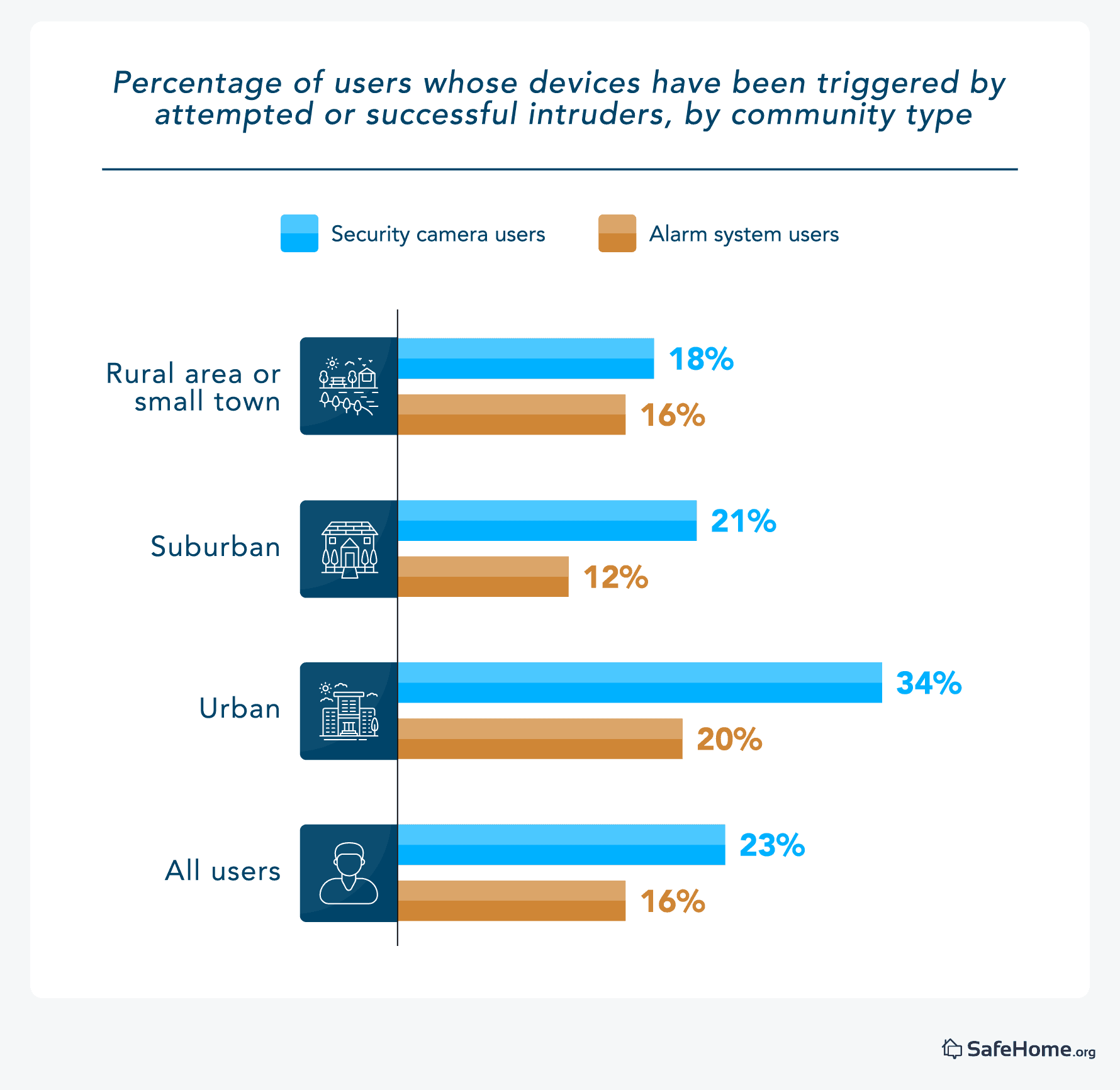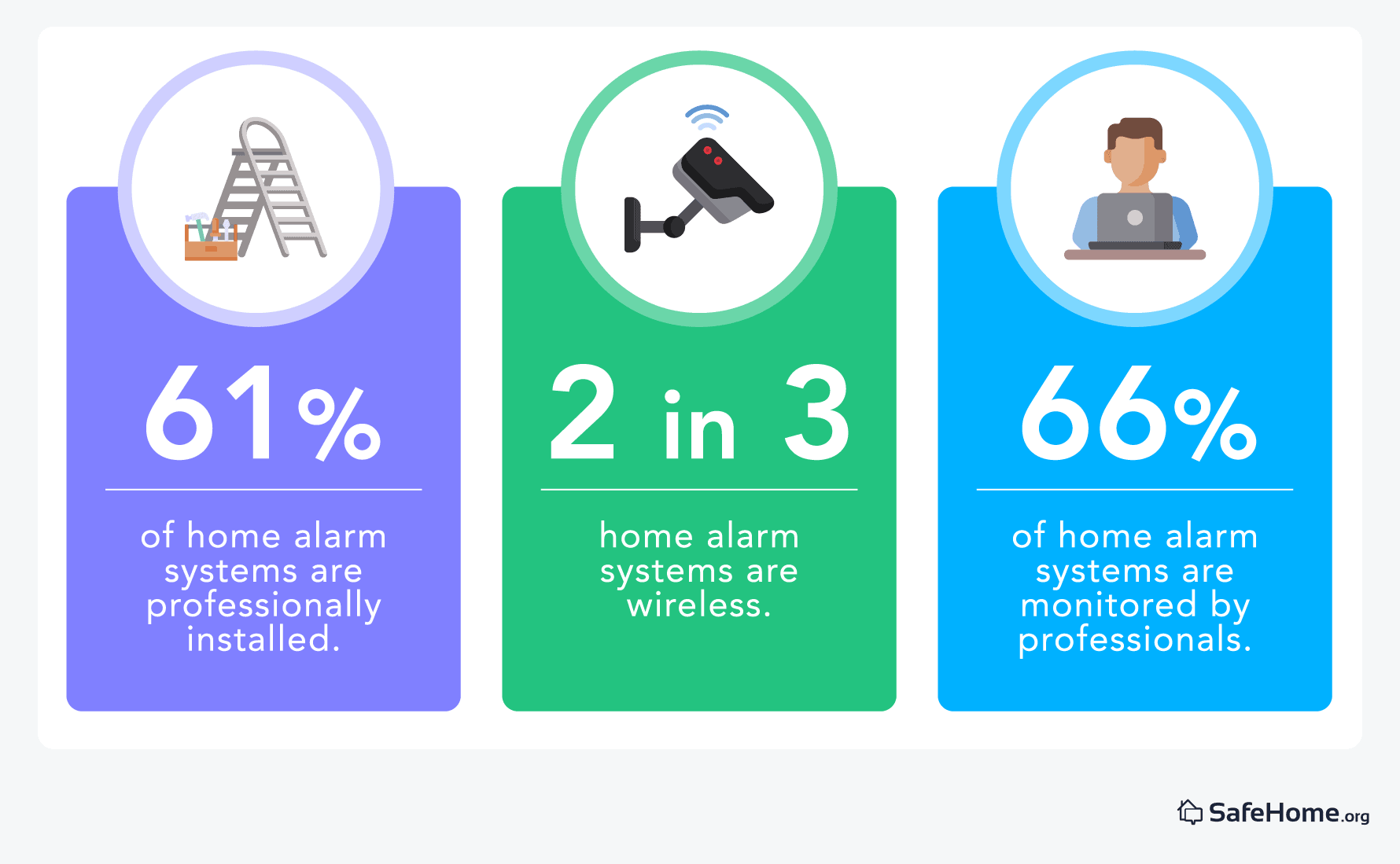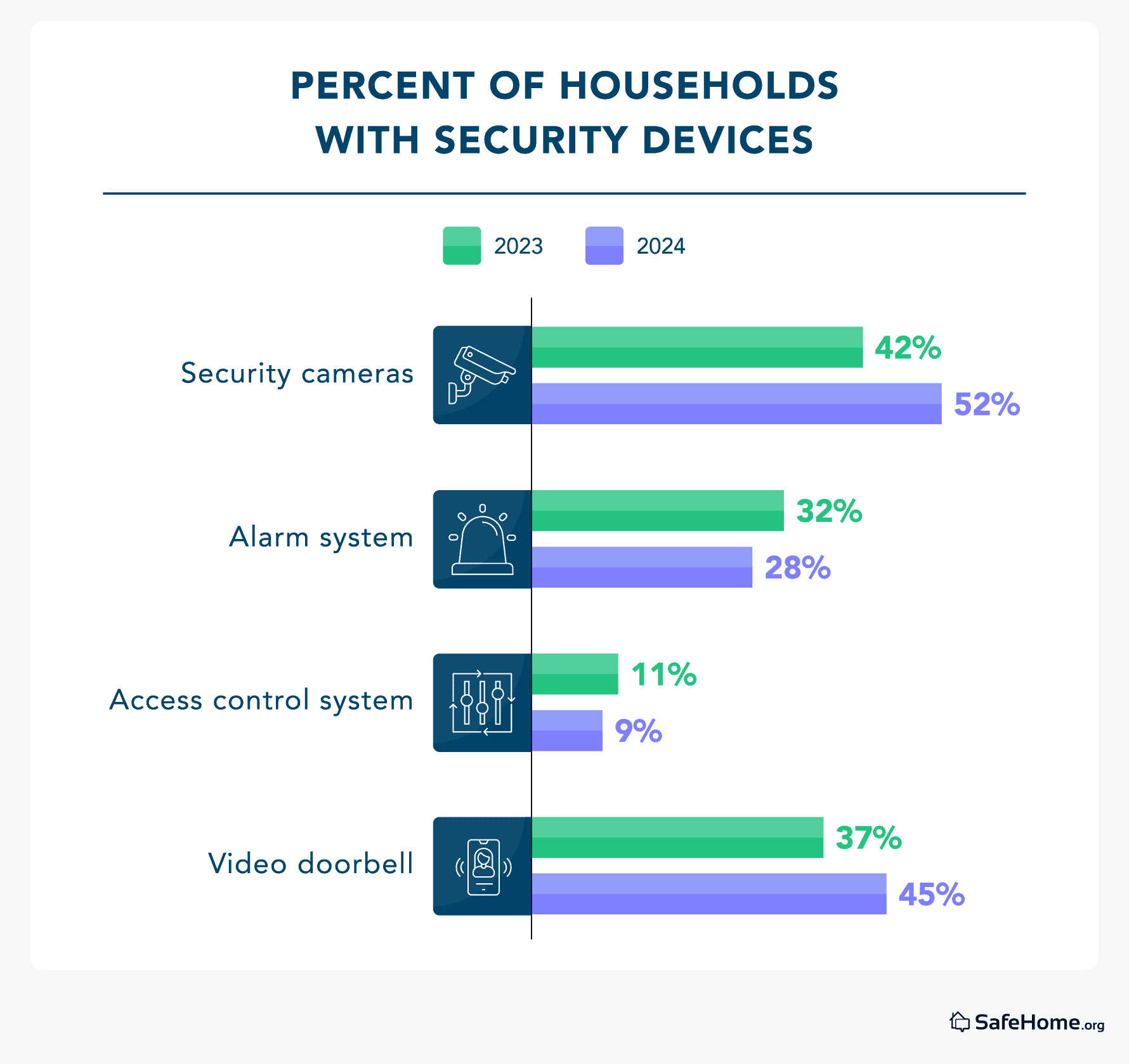2025 Home Security Market Report
Home security is essential to peace of mind for millions of Americans. As technology continues to evolve, the options for safeguarding our homes have expanded far beyond traditional locks and keys. From smart cameras to biometric access controls, today's systems deter crime and provide insights into our daily lives, blending convenience with protection. As a result, consumers are taking notice.
To better understand Americans’ relationships with home security devices, we gathered insights from more than 1,000 people to understand the current home security market. Our annual report highlights how Americans use security systems today, what motivates their purchases, and how this rapidly expanding market may change in the coming year.
Key Findings:
- Around 94 million U.S. households use some type of security system such as cameras, alarms, or access control tools.
- Security camera usage increased significantly between 2023 and 2024 among both homeowners and renters. Today, more than 50% of homes have at least one security camera.
- Most home alarm system users are motivated by factors other than crime risk. The most common reason people used alarm systems was because they had children in the home.
- Two brands dominate the home alarm system market: ADT and Ring. 29% of households with alarm systems use ADT, and 28% use Ring Alarm.
- The home alarm system market will expand in 2025: More than 13 million U.S. households may install new home alarm systems within the next 12 months.
How Common Are Home Security Systems in the U.S.?
Our research shows that home security system use has increased among Americans, with over half having some security device. Among the four types of devices we studied — cameras, alarms, access controls, and video doorbells — cameras were the most popular, with 52 percent of households having at least one security camera.
The use of security cameras has increased since last year, as well as the use of video doorbells. Video doorbell use rose 12 percentage points, the highest increase of any type of security system. Alarms and use-access control systems both dropped slightly over the same period.
Our research suggests that millions of households are using security systems. At least 14 million households use access control systems, and 68 million homes have security cameras today. Only one in four households have no security devices at all.
Across the board, homeowners are more likely than renters to use home security devices, which likely speaks to the degree of control homeowners have over their spaces. That said, home security tools remain popular even among renters, who may be bound by lease agreements forbidding them from making certain alterations.
Nearly half (42 percent) of renters use home security cameras, only slightly higher than those who use video doorbells (37 percent). Notably, renters are almost as likely as homeowners to say they have use-access control systems. Such technology is favored in high-density housing and among corporate landlords.
All types of home security devices are growing in popularity among both homeowners and renters. Just 21 percent of homeowners say they don’t have a security system, down from 25 percent last year; 30 percent of renters say the same, down from 36 percent in 2023.
Why People Use Home Security Systems
We wanted to understand what motivates people to purchase or use home security systems. Among those using alarm systems, for example, the presence of children in the home was a key motivator. Frequent travel and high-value possessions also motivated this group to adopt home security devices. However, they focused less on things like the risk of crime (10 percent) or disasters (two percent).
| Motivations for using home alarm systems | Percent of home alarm system users |
|---|---|
| Have children | 33% |
| Frequently travel or spend time away from home | 31% |
| Own lots of valuable items | 26% |
| The system was already installed when I moved in | 18% |
| Past break-ins or crime experiences | 18% |
| Older adults in the home | 12% |
| Live alone | 11% |
| Live in a high-crime area | 10% |
| Live in an area prone to fires or disasters | 2% |
Note: Multiple selections allowed
There was little difference between renters and homeowners, as both groups had the same top five reasons for using alarm systems.
The reasons for using alarm systems are more nuanced than simply mitigating crime risk. Interestingly, most alarm system users selected motivations other than crime prevention, which may be linked to the fact that 62 percent of people consider their homes very safe. This perception of safety is further supported by broader societal research, including Gallup data showing improvements in crime perception.
In 2024, the percentage of Americans believing crime is an “extremely” or “very serious” problem declined from 63 percent in 2023 to 54 percent in 2024. These statistics suggest that while security concerns persist, homeowners' decisions to install alarm systems are influenced by a complex mix of factors beyond direct crime risk.

Top Alarm System Brands
Two brands dominate the home alarm system market: ADT and Ring. Of users with home alarm systems, 29 percent use ADT products, and 28 percent use Ring Alarm products. Our research shows slight differences between homeowners and renters, with ADT leading for homeowners and Ring leading for renters.
| Alarm system providers | Percent of users |
|---|---|
| ADT | 29% |
| Ring Alarm | 28% |
| SimpliSafe | 13% |
| Nest | 11% |
| Honeywell | 8% |
| Vivint | 7% |
| Xfinity | 7% |
| Wyze | 6% |
| Brinks | 6% |
| AT&T Digital Life | 4% |
| Guardian | 3% |
| CPI Security | 2% |
It’s too early to tell whether ADT’s acknowledgment of a pair of breaches targeting employee and customer data will impact its market standing. However, if Ring’s status as a leader is any indication, ADT is likely to remain at the top of the heap. In 2024, more than 100,000 Ring customers started receiving payments as part of a settlement the Amazon-owned company reached with the Federal Trade Commission over allegations that Ring improperly handled and failed to protect customers’ video footage.
>> Related Reading: ADT Home Security Review
Most Popular Security System Features
Our research reveals that home security system users value the ability to integrate smart home apps and devices, allowing them to create highly personalized security ecosystems. While some add-on technologies prove more popular than others, users appreciate the flexibility to expand and customize their home protection beyond traditional alarm systems, connecting everything from smart cameras and motion sensors to integrated mobile applications that provide real-time monitoring and control.
Our research shows outdoor cameras, motion sensor lights, floodlights, motion sensors, and internal cameras are the five most popular security system features. Almost two-thirds of people (63 percent) own a system with outdoor cameras. While we did not ask about outdoor cameras in 2023, our research shows that the majority of the most popular features are holding steady or even rising in popularity.
Popular Home Security System Features
Among security system users
| Home security features | Percentage of users (2023) | Percentage of users (2024) |
|---|---|---|
| Outdoor cameras | – | 63% |
| Motion sensor lights | 36% | 43% |
| Floodlights | 37% | 35% |
| Motion sensors | 26% | 32% |
| Internal cameras | 24% | 33% |
| Smart smoke detectors | 23% | 33% |
| External signs | 22% | 24% |
| Smart carbon monoxide detectors | 22% | 30% |
| Smart locks | 14% | 20% |
| Window open sensors | 16% | 18% |
| Entryway sensors | 25% | 19% |
| Glass breaking sensors | 12% | 11% |
| Key fobs | 10% | 12% |
| Panic buttons | 8% | 6% |
| Home automation controls | 8% | 12% |
| Water/flood detectors | 6% | 8% |
Some features are also rapidly gaining traction with users, including smart smoke detectors, which have risen 10 percentage points, and smart carbon monoxide detectors, which have climbed eight percentage points since our last report.

The U.S. AI market, valued at more than $750 billion in 2025, is projected to balloon to $3.6 trillion over the next decade. Given the massive investment in AI across all sectors of the economy, security brands will likely continue to roll out these advanced features.

Most customers also prefer professional help with security system monitoring. About half chose standard professional monitoring, and 16 percent opted for advanced monitoring, where security staff can respond to threats directly.
How Consumers Choose Home Alarm Systems
When choosing a home alarm system, professional monitoring is the most critical factor for users overall, ranking higher than price and well above features like smartphone apps, easy installation, or brand name.
| Which of these factors is most important when selecting a home alarm system? | All users |
|---|---|
| Professional monitoring options | 28% |
| Price | 22% |
| Integration with apps and smart devices | 18% |
| Ease of installation | 13% |
| Brand | 9% |
| Month-to-month contract option | 7% |
| Portability | 2% |
| Other | 1% |
However, location plays a vital role in these preferences: rural and small-town residents have different priorities, with only 19 percent valuing professional monitoring (compared to 28 percent of all users). Instead, these rural customers focus more on price and the ability to connect their alarms with smart home devices and apps.
Cost emerges as the top priority for city dwellers and ranks second among all users when choosing an alarm system. Most users invest around $400 for installation and about $40 monthly for monitoring services. The fact that only nine percent of users received free installation suggests that people are willing to spend money to ensure their homes are adequately secured.
Home Security Market Outlook for 2025
The outlook for the home security market in 2025 is strong, with high growth potential among both renters and owners. Overall, 51 percent said they were considering purchasing a home security product in the coming year.
Our research estimates that about 14 million Americans are considering purchasing home alarm systems in the next year, and as many as 32 million are interested in doorbell cameras. We expect security cameras to have the highest growth potential among all consumers.
How many people are considering home security purchases in the next 12 months?
| Type of device | Percent of homeowners | Percent of renters | Percent of all non-users |
|---|---|---|---|
| Some type of security product | 50% | 54% | 51% |
| Home security cameras | 26% | 26% | 26% |
| Video doorbells | 24% | 27% | 25% |
| Home alarm system | 10% | 11% | 10% |
| Access control system | 7% | 7% | 7% |
| Professional monitoring | 6% | 7% | 6% |
| None of the above | 50% | 46% | 49% |
Notably, interest in purchasing home security products of any type is slightly higher among renters than homeowners. However, at least half of each group is weighing their options in this area.
Though our research showed that most Americans feel safe at home, the home security market shows no signs of slowing. In 2025, many will consider their first entry into security system ownership, and others will add new tools or features to their existing home security stack.
As security companies introduce more advanced features powered by AI and machine learning, these technologies will likely become standard offerings, providing homeowners and renters with even more sophisticated protection options.
Methodology
In October 2024, SafeHome.org conducted an online poll of 2,145 American adults regarding their home's safety and security. Homeowners comprised 67 percent of our respondent pool, with renters representing 33 percent. The respondent pool was 53 percent men and 46 percent women, with one percent declining to disclose their gender. Their ages ranged from 18 to 82, with a median age of 48.
Sixty-five percent of participants were white, 11 percent were Black, 18 percent were of multiple ethnicities, six percent were Asian, and about one percent preferred not to answer. Fifty-two percent of participants lived in the suburbs, 26 percent lived in an urban area, and 22 percent lived in a small town or rural area.

